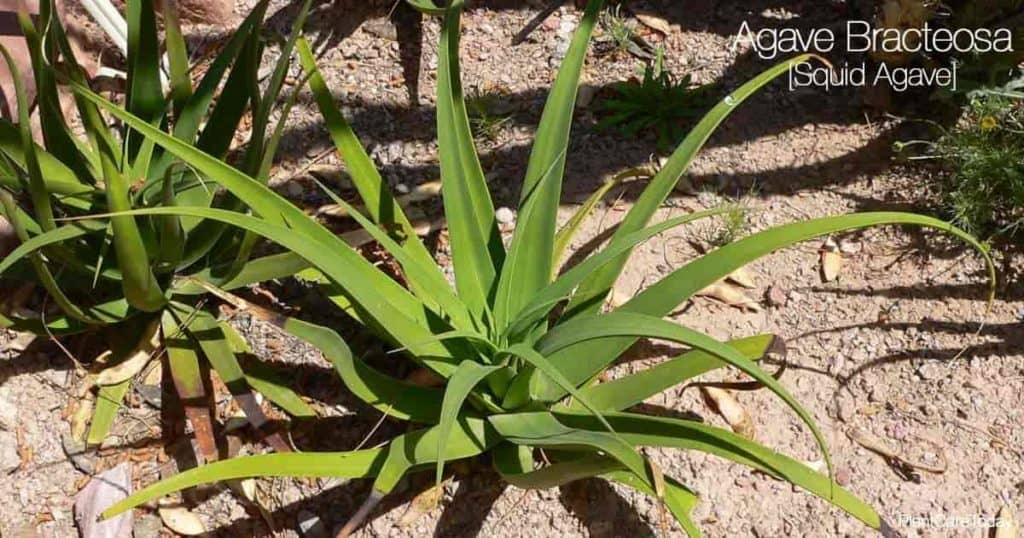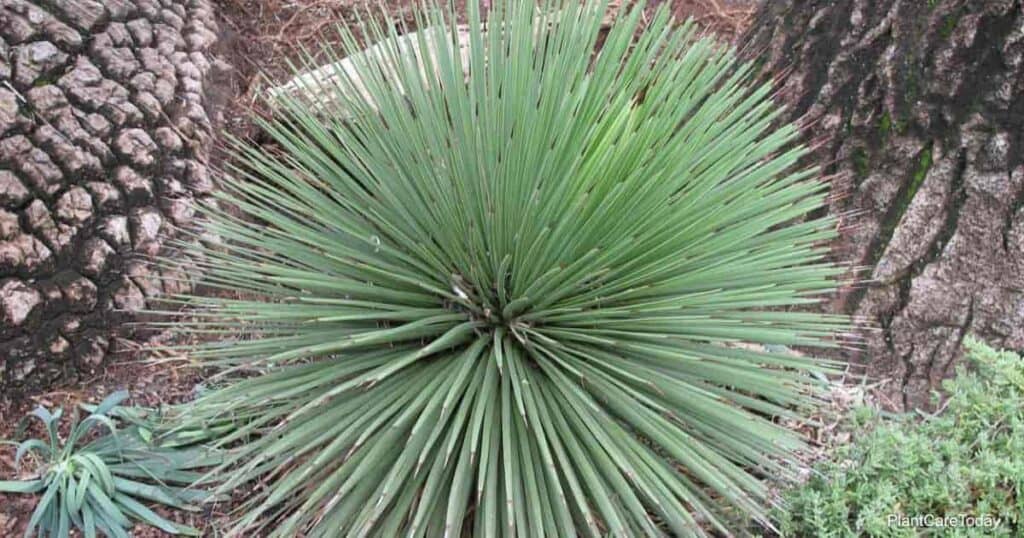The Agave Plant is a group of over 200 species of succulents, all hailing from the New World desert or near-desert areas of South America, Central America, Mexico the Southwest United States, and even the Caribbean.
These large, tough, cactus-like plants in the Agave family are amazingly useful and economically valuable to the people in these areas.

Agaves are used to produce a wide variety of products ranging from:
- Rope
- Sweetener
- Liquors mezcal (tequila) and beer-like drink called pulque
- Bio-fuel
In addition to being a valuable crop, these stunning plants make great houseplants.
Agave plant types are not very susceptible to pests or diseases. However, the agave snout weevil can be a problem, especially for larger species such as agave Americana.
It grows among the pines and oaks, something that helps it to withstand the drought. It has smoky, light, and subtle flavors unique to its kind.
They also, make excellent additions to Mexican and Southwest-inspired landscapes, desert landscaping, and xeriscaping to go with attractive cacti, yucca, and aloe plants.
- Many Agave Plant Varieties
- Popular Types and Varieties Of Agave Plants
- Agave Americana (Century Plant)
- Agave Victoriae-Reginae (Royal Agave)
- Agave Blue Glow
- Agave Filifera (Thread Leaf Agave)
- Agave Attenuata (Foxtail Agave)
- Agave Parviflora
- Agave Tequilana (Blue Agave Plant)
- Agave Parryi (Artichoke Agave)
- Agave Desmettiana (Smooth Agave)
- Agave Geminiflora (Twin Flower Agave)
- Agave Vilmoriniana (Octopus Agave)
- Agave Potatorum (Butterfly Agave)
- Agave Angustifolia (Caribbean Agave)
- Agave Ovatifolia (Whale Tongue Agave)
- Agave Macroacantha (Black-Spined Agave)
- Agave Lophantha
- Agave deserti (Desert Agave)
- Agave Bracteosa (Squid Agave)
- Agave Montana (Mountain Agave)
- Agave Salmiana
- Agave Stricta (Hedgehog Agave)
- Agave Shawii (Coastal Agave)
- Agave Colorata (Ash Agave)
- Agave Titanota (Rancho Tambor Agave)
In this article, we will share information on some of the most popular, small agave species and agave succulent types. Read on to learn more.
Many Agave Plant Varieties
When seeking out just the right plant agave type for your setting, you will have a lot of different agave plants that are excellent choices.

Of the more than 200 species of agave, several dozen are cultivated for agricultural, industrial, landscaping, and home use.
Some Agave plants are small, potted-plant-sized specimens with sharp terminal tips and some are giants that will tower over your home when blooming time comes.
Do All Different Types of Agave Plants Die After Blooming?
Yes, after flowering, Agaves slowly die. However, most send out new suckers or pups. It may take decades for an Agave to flower.
Blends of multiple agave plants types, called ensembles, are made for a variety of reasons. Rather than blending finished mezcals (the way winemakers blend different wines after fermentation), ensembles are usually cooked, fermented, and distilled together, akin to a field blend wine.

Learn more in the article: What To Do When Your Agave Plant Blooms?
How Tall Do Agave Plants Get?
The size of Agaves varies depending on the variety. Small agave plant only grows 18″ inches tall with an 18″-24″ inches spread.
Other agave varieties, like the century plant, reach 6′ to 8′ feet in height with a 10′ foot spread.
Flower spikes range from 8′ feet to as tall as 60′ feet high on the large varieties.

Agave Topics Of Interest:
- Agave Snout Weevil – Identify, Control, and Treat Snout Weevils
- Are Agave Plants Poisonous or Toxic?
- Growing Agave Seeds
Popular Types and Varieties Of Agave Plants
Agave Americana (Century Plant)
Agave americana is commonly referred to as the American Century Plant Agave or Maguey in Mexico.
This plant has very attractive blue-green leaves featuring prominent, saw-toothed spines.
The common variety is a solid bluish color. There are several variegated forms, such as Agave Americana Marginata.

Both grow quite large and make good specimen plants in an open setting. [source]
On the flip side, there is another variegated variety, Agave americana mediopicta, with a central yellow stripe and green margins on the leaves.
Agave Victoriae-Reginae (Royal Agave)
Agave victoriae-reginae or Queen Victoria Agave is a smaller plant with upright, black-tipped leaves that curve inward to form a compact dome.
This is a good choice as a container or potted plant or as a border plant, as it only grows to be about a foot to 18″ inches tall.

The plant lives to be 20 or 30 years old and produces pretty, cream-colored, or reddish-purple flowers on a fifteen-foot stalk as its swan song.
Agave Blue Glow
Agave Blue Glow is a small, slow-growing succulent agave hybrid. Blue Glow reaches a height of one or two feet with a spread of 2′ or 2′ feet, forming a dense rosette of blue-green leaves.
Agave Tequilana, better known as Blue Weber agave, is another variety of the Agave Angustifolia species.

Blue Glow is a cross between Agave attenuata and Agave ocahui and was developed at Rancho Soledad Nurseries of Rancho Santa Fe, California, by horticulturist Kelly Griffin.
Agave Filifera (Thread Leaf Agave)
Agave Filifera is also known as the Thread Agave. The plant is very attractive, with dark green leaves that may have a slightly bronze cast.

The leaves are edged in white and feature festive white thread-like filaments. This medium-sized plant grows about 3′ feet wide and 2′ feet high. [source]
Agave Attenuata (Foxtail Agave)
Agave attenuata is also called Dragon Tree or Foxtail.
The Agave attenuata plant grows to be four or five feet high and wide with a curved inflorescence holding greenish-yellow flowers on the spike, which earned attenuata the common name, Fox Tail agave.

It is a spineless variety with soft, attractive, pliable, and threat-free green leaves. When it is young and small, it makes an attractive, easy-care houseplant.
As a container plant or in the landscape, Attenuata does not present the dangers of its more aggressive cousins.
This is a good choice as a poolside plant or in a small yard where avoiding the plant might be difficult. [source]
Agave Parviflora
Agave parviflora is also known as the Small Flower Agave, Small Flower Century Plant or the Santa Cruze striped agave. This small, delightful plant only reaches a height of about eight inches.
Agave parviflora is similar to Agave filifera in that it also produces pretty “hair” filaments in curls around its compact, attractive leaves.
This plant’s flower stalk stands 3′ to 7′ feet high and produces pretty yellow or cream-colored flowers that are very attractive to bees and other pollinators. [source]
Agave Tequilana (Blue Agave Plant)
Tequilana azul is also known as Weber’s Blue Agave, Tequila Agave, or simply the Blue Agave plant, where agave nectar comes from.
This is the plant that is used in making tequila. It is also a good landscaping plant for gardeners in high altitudes.

These plants prefer rich, well-drained, sandy soil. The plants grow quite large and can live for several decades. If you take one on, be prepared for a commitment! [source]
Agave Parryi (Artichoke Agave)
Agave Parryi (Artichoke Agave) is a strikingly beautiful plant with sharp black spears tip the ends of the broad, bluish-gray-green leaves. Grow on rocky, dry slopes.
The sun-loving plant makes a wonderful potted specimen.

Agave Desmettiana (Smooth Agave)
Agave Desmettiana (Smooth Agave) is a soft, smooth, ‘people-friendly’ agave. Produces clumps of pups from basal offshoots.
Strong focal or accent plant in desert gardens. Excellent for use around patios. Plant as single specimens or in groups spaced at 5′ to 6′ feet on the center.

Agave desmetiana variegata is the variegated form of desmetiana and makes a wonderful potted specimen.
Agave Geminiflora (Twin Flower Agave)
Agave Geminiflora (Twin Flower Agave) is also known as the pincushion agave. The hundreds of leaves form a whorl of dense, symmetrical, rounded, dense, compact rosette.

Agave Vilmoriniana (Octopus Agave)
Agave Vilmoriniana is better known as the Octopus Agave and is an unusual-looking succulent agave with rosettes growing 3′ – 4′ feet high and 5′ – 6′ feet wide.
One of the ‘friendlier’ Agaves, with fine, soft serrations along the leaf margins and a soft terminal spine.

Agave Potatorum (Butterfly Agave)
Agave Potatorum is more commonly known as the “butterfly agave.”
The leaves resemble the wings of a butterfly. It is a slow-growing, medium-sized agave and makes an attractive potted plant.

When grown in a container, it is very easy to control its size.
Agave Angustifolia (Caribbean Agave)
Agave Angustifolia, also known as the Caribbean Agave, is a rosette-forming narrow-leaved variegated Century Plant growing to about 4′ feet high and wide.
Pale green agave leaves with creamy-white margins, quite stiff with very dangerous, sharp spines on the leaf tips.

Flower stalk sometimes produces tiny plantlets or bulbils for replanting. Fragrant attract pollinators.
Agave Ovatifolia (Whale Tongue Agave)
Agave ovatifolia is a beautiful agave from northeastern Mexico. Ovatifolia is cold hardy, and easy to grow.
Perfect as an accent plant in sunny borders, rock gardens, succulent gardens, Mediterranean gardens, and southwest-themed gardens.

Agave Macroacantha (Black-Spined Agave)
Agave Macroacantha, known as the Large-Thorned or Black-Spined Agave, has medium-sized leaf rosettes with narrow blue-gray leaves ending in sharp 1” inch black terminal spines at the tips.
Plant form a colony with offsets. Flowers have a purplish-green color, usually small, with no distinct scent. Prefers full sun.
Agave Lophantha
Agave Lophantha is green, but Agave Lophantha ‘Quadricolor’ is a variegated plant with yellow stripes and a pale green mid stripe down the dark green leaves with reddish edges lining the teeth.
The variety Agave lophantha ‘Splendida’ 2013 was picked as a Florida Garden Select Plant. Creamy-gold center stripe runs down the dark green rosettes.


Many agave species typically grow slowly and take plenty of time to outgrow their pots.
Agave deserti (Desert Agave)
Desert Agave is one of the most drought-tolerant of the 136 species of agave found in North America and grows on stony terrain from south-eastern California and south-western Arizona to Baja California and northern Sonora.
Agave Bracteosa (Squid Agave)
Agave bracteosa aka Squid Agave, also known as the Candelabrum Agave, is a slow-growing, drought-tolerant species. Makes a wonderful potted specimen, a conversation starter, and right at home in the rock garden.

Agave Montana (Mountain Agave)
Agave Montana is known as the mountain agave since it comes to the high mountains at around 9,000 feet above sea level.
In its natural habitat, this type of agave species generally grows as an understory plant.

Agave Salmiana
Agave salmiana is a large growing plant that reaches heights up to 6’ feet and spreads up to 12’ feet.
Mature plants develop large, dark green leaves with sharp, serrated margins.

Agave Stricta (Hedgehog Agave)
Agave stricta is a perennial succulent evergreen plant native to Puebla and Oaxaca in Southern Mexico. It has narrow rosettes and spine-tipped dark green leaves.

Agave Shawii (Coastal Agave)
Agave shawii is the westernmost agave species, found only in Baja, Mexico, and along the coast of southern California.
Shawii is critically endangered in its native environment. Shawii is critically endangered in its native environment.

Agave Colorata (Ash Agave)
Agave Colorata is native to the coastal areas of Sonora, Mexico. It thrives in warmer climates, with full sun and low water.

Agave Titanota (Rancho Tambor Agave)
Agave Titanota, aka the Rancho Tambor Agave, is a slow-growing compact solitary rosette that reaches a maximum height of 1′ – 2′ feet and a width of 2′ – 3′ feet.
Light-colored green leaves 1′ to 2′ feet long and about 5″ inches wide. The terminal thorns are interestingly flat.

These are just a few of the best types of agave plants for the home and garden.
Check out this collection of 15 types of agave cactus for use as potted plants or in sunny areas around your home:
NOTE: Polianthes tuberosa is now known as Agave amica.

